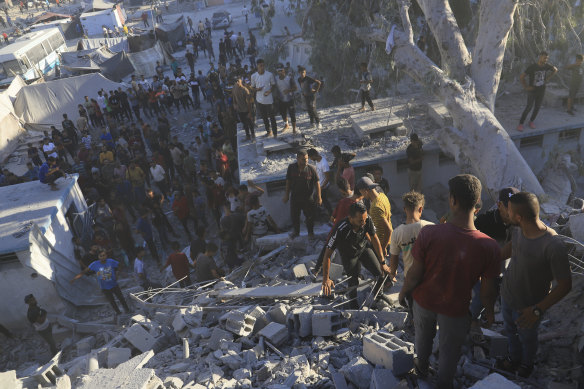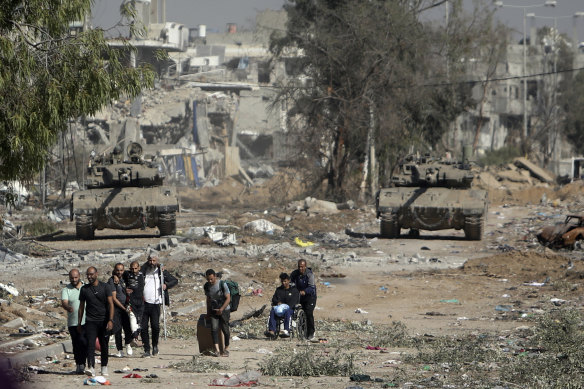‘Endless cycle of death and displacement’: Weary Gazans on the move again
By Raja Abdulrahim
Jerusalem: An evacuation order by the Israeli military this week covering roughly a third of the Gaza Strip came as people there are less and less equipped to handle repeated forced displacements, after nearly nine months of war that have left tens of thousands dead and injured and put the territory at risk of famine.
The order, which the United Nations has estimated affects about 250,000 people, was the largest since October, when about 1 million residents of northern Gaza were told to flee their homes, the organisation said this week.

Palestinians search for bodies and survivors in the rubble of a residential building destroyed in an Israeli airstrike.Credit: AP
“It’s an endless cycle of death and displacement,” said Louise Wateridge, a spokesperson for the main UN agency that aids Palestinians, UNRWA, in voice messages from central Gaza.
“People express here that they are losing hope, they are losing the willpower, faced with another forced displacement and absolutely no certainty of safety.”
The Israeli military issued the warning to leave large parts of the cities of Khan Younis and Rafah on Monday (Gaza time), and by Tuesday thousands of people had begun to flee. The order was followed by a night of heavy bombardment in areas of southern and central Gaza.
It came after the Israeli military said Palestinian armed groups fired a barrage of roughly 20 rockets from Gaza towards Israeli cities on Monday.

People flee from northern Gaza as Israeli tanks block a road last November.Credit: AP
A spokesperson for UN Secretary-General Stéphane Dujarric said his colleagues were “deeply concerned” about the impact of the order.
“People are left with the impossible choice of having to relocate, some most likely for the second or even the third time, to areas that have barely any spaces or services, or staying in areas where they know heavy fighting will take place,” he said.
The order covers more than 90 school buildings, many of which have turned into overcrowded shelters as people run out of places to stay, along with four medical facilities, Dujarric said.
Among them is the European Hospital in Khan Younis, where many were sheltering and hundreds of patients were being treated. The International Committee of the Red Cross said on Wednesday that the hospital was no longer functioning because so many staff, patients and others had left.
‘It’s been eight months of war … people are a lot weaker, there’s more injuries, there’s been less medicine, less fresh fruit, less water.’
Louise Wateridge from the main UN agency that helps Palestinians
Though many people in the evacuation zone have made the decision to flee once again, relocating becomes harder and harder as the war drags on.
“In terms of people’s ability to move, it’s been eight months of war; people are extremely fatigued, they’re exhausted, they’re malnourished,” Wateridge said. Healthwise, she said, “people are a lot weaker, there are more injuries, there’s been less medicine available, less fresh fruit, less water.”
More people are also fleeing on foot, she said, and so are taking fewer belongings with them.
Heba Usrof, 29, a singer living in Khan Younis, said she only knew of the evacuation order when she saw hundreds of people passing by outside. A few were carrying mattresses, while others had only backpacks, she said.
“They were not carrying much stuff this time,” Usrof said. “I believe they were too tired to keep carrying stuff from one place to another, and they no longer have money to pay for trucks.”
Usrof said she was living with her family of five in what was left of their two-storey home, in a part of the city that is not under the evacuation order. If tanks approach their home and they have to flee again, she said, she might take only her ID, mobile phone and a change of clothes.
This article originally appeared in The New York Times.
Get a note directly from our foreign correspondents on what’s making headlines around the world. Sign up for the weekly What in the World newsletter here.